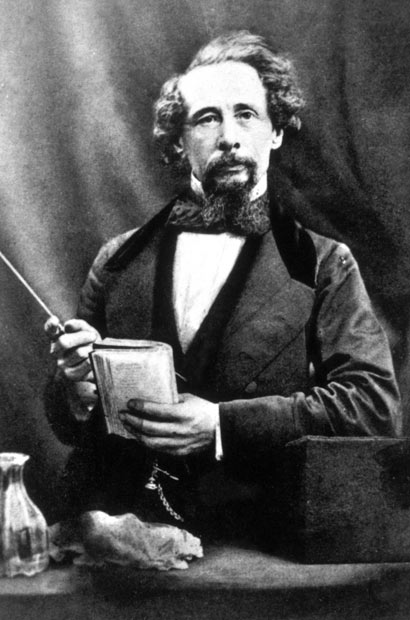The Man Who Invented Christmas: Charles Dickens' Success at Changing the World through Meaningful Art
Unlike children in Western world, I grew up not knowing of Christmas, not to mention A Christmas Carol. This granted me the chance to look at the tale and the man behind the tale with utter innocence.
Though my family didn't celebrate Christmas, I spent the morning of 25th December listening to a reading of A Christmas Carol, absorbed and delighted by the fervency in the voice of Patrick Stewart, who must have loved this story so much, and who himself played the protagonist - Mr. Scrooge - in its movie adaptation. This was my first time listening to the greatest Christmas tale of all time, the tale that entitled Charles Dickens "the man who invented Christmas".
Invented what of Christmas? You may wondering, for certainly Christmas was invented in the Bible, which was certainly not written by Dickens.

Well, let's first say one of his inventions was the term "Merry Christmas!" Together with it, Dickens revived the seasonal merriment and festivity, which had been suppressed by the Puritan sobriety at the time in England. New customs such as Christmas trees, Christmas cards, carol singing were widely and joyously adopted under the influence of A Christmas Carol. He rejuvenated how England celebrated Christmas. And eventually, how the world celebrated Christmas.
Most importantly, in my opinion, he hatched goodness and love in the heart of Christmas. Almost immediately after its first publication in 1843, A Christmas Carol spurred acts of kindness and charitable generosity to the poor - a tradition well maintained in over 150 years to this day.
This is the power of meaningful art.
-
Meaningful art doesn’t stop at entertaining. Meaningful art penetrates and awakes goodness.
-
Meaningful art not only moves us to laughter or tear, fill us with the pleasure of beholding surreal beauty; but also makes us pause and wonder “How do I want to spend my short, precious life?”
-
Meaningful art carries a moral lesson that doesn’t impose but invite.
-
Not least, meaningful art reaches widespread audience through its simplicity and entertainment.
A Christmas Carol is the testament of meaningful art. Though perhaps out of Dickens’ expectation, its effects did not happen by chance.

Humiliating childhood, haunting exposure to the poor in his 20s, and unwavering humanitarian vision compelled Dickens to make societal change through his writing. The 31-year-old British writer wanted to create something conveying strong moral lesson. Only, he wasn’t sure what this something should be.
In the process of figuring it out, Dickens realized that the most effective way to make the broadest segment of the population aware of poverty and injustice was to write a deeply felt Christmas narrative. Thus, he changed his mind from writing a essay to writing a novella. An Appeal to the People of England, on behalf of the Poor Man's Child – the title of his first intended essay – became A Christmas Carol.
Charles Dickens was right.


Marley was dead: to begin with.
That’s how the story begins. A Christmas Carol is no typical Christmas tale of sweetness, light, joy, warmth. The world Dickens creates was intertwined with bitterness, darkness, despair and cold. In this world, there are real images of hunger and poverty; there are also magic and spirits. This creates depth and believability for a fantasy fiction that absorbs both children and adults.
It begins with death; it ends with rebirth. Intentionally or not, this echoes the notion that one can fully come alive only when one is aware of death.
Dickens was one of the few artists who knew how to mix his Talent and his Care to create a masterpiece at the right time in history, and thus, changed history.

Ironically, while having been spurred charitable donations in the last 150 years, in those days, A Christmas Carol was a financial disappointment for Charles Dickens. Despite not getting the money needed to support his family and his pregnant wife, the young Dickens adored the deep moral lesson of this story: Mr. Scrooge - a bitter, stringy, cold, selfish and cruel old man, doomed to a lonely death – is given the chance to alter his faith. Scrooge takes it, and at the end of the story becomes a lighthearted, loving, charitable, happy person. Dickens hoped his protagonist’s redemption made his readers believe in a second chance to live a good life in a selfish world that has shut down their heart.

After one and a half century, old Scrooge once obsession with gain is still reflected in the modern world, perhaps ever more strongly. Many found Christmas under twinkling pine trees; few found Christmas in their hearts. We have commercialized Christmas. Like the lament of The Spirit of Christmas Present:

There are some upon this earth of yours who lay claim to know us, and who do their deeds of passion, pride, ill-will, hatred, envy, bigotry, and selfishness in our name; who are as strange to us and all our kith and kin, as if they had never lived.
A Christmas Carol reminds the world what Christmas is really about:

a good time; a kind, forgiving, charitable, pleasant time; the only time I know of, in the long calendar of the year, when men and women seem by one consent to open their shut-up hearts freely, and to think of people below them as if they really were fellow-passengers to the grave, and not another race of creatures bound on other journeys. And therefore… though it has never put a scrap of gold or silver in my pocket, I believe that it has done me good, and will do me good; and I say, God bless it!

--- Source: Wikipedia
